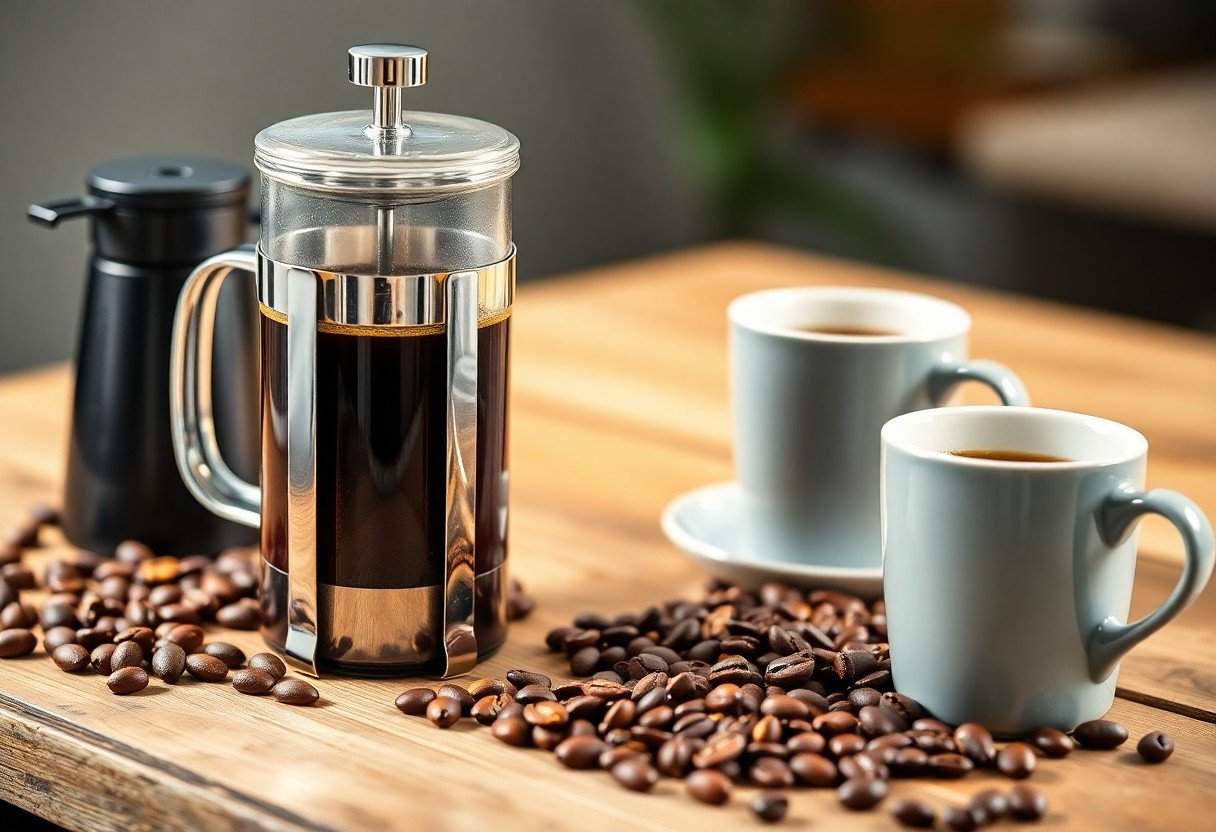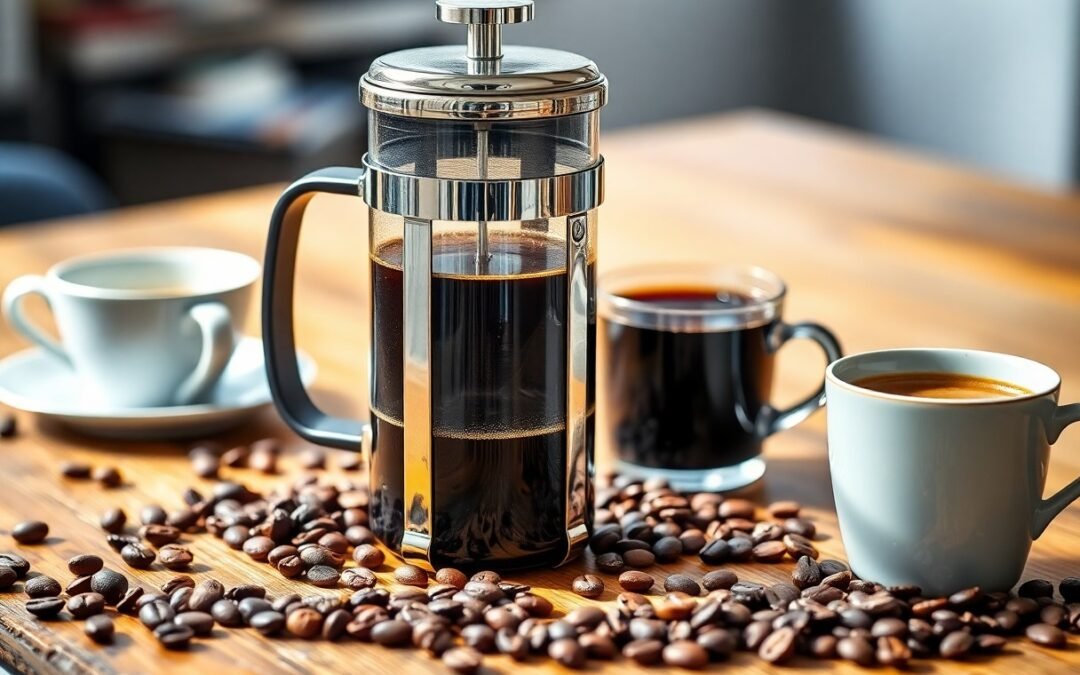Most coffee enthusiasts agree that mastering the art of French press coffee can elevate your morning routine and impress your friends. With its rich flavor and full-bodied texture, brewing French press coffee is both an art and a science. In this guide, you’ll learn the necessary techniques and tips to perfect your brewing process, ensuring that every cup you serve is smooth, robust, and worthy of a cafe experience. Let’s probe the steps that will transform you into a French press coffee aficionado.

The Art of Selecting Coffee Beans
Choosing the right coffee beans can elevate your French press experience significantly. Opt for whole beans instead of pre-ground coffee; this guarantees maximum freshness and flavor. The origin, processing method, and roast level of the beans will all impact the final brew, so it’s necessary to be intentional about your selection. A diverse range of flavors can be discovered by exploring beans from different regions and farms, allowing you to create a truly unique cup of coffee every time.
Understanding the Bean Profiles
Each coffee bean offers a distinct flavor profile that varies by region, variety, and processing method. For instance, Ethiopian beans often showcase bright floral notes and fruity acidity, while Colombian beans may present a balanced richness with nutty undertones. Familiarizing yourself with these profiles can empower you to choose beans that precisely match your taste preferences for the most satisfying French press brew.
Sourcing High-Quality Beans
Sourcing high-quality beans involves connecting with reputable suppliers who prioritize freshness and sustainable practices. Look for roasters who provide detailed information about their sourcing practices, including the origin of the beans and their relationships with farmers. Strive for specialty-grade beans, as these are meticulously cultivated and processed, offering the best flavors and aromas. Engaging with local coffee shops or subscription services can also lead you to unique blends and single-origin options that you may not discover otherwise.
When sourcing high-quality beans, consider exploring direct trade or fair trade options, as these practices ensure farmers receive fair compensation. Look for roast dates on bags, steering clear of overly stale beans—ideally, you want beans roasted within the last two weeks for optimal freshness. Many specialty coffee roasters now offer tasting notes and brewing recommendations right on the packaging, making it easier for you to make informed choices about which beans to try in your French press.

Mastering Your Grind Size
Grind size plays a vital role in the flavor profile and overall quality of your French press coffee. A medium-coarse grind provides the best balance, allowing for proper extraction without over-extraction bitterness. Aim for consistency in your grind; whether you’re using a burr grinder or a blade grinder, you want similar-sized particles for a uniform brew. This makes a noticeable difference in taste and texture, ultimately taking your coffee from mediocre to remarkable.
Importance of Grind Consistency
Achieving a consistent grind ensures that all coffee grounds extract at the same rate, leading to a balanced flavor in your cup. Inconsistencies can result in some grounds being over-extracted, causing bitterness, while others are under-extracted, leading to a sour taste. Maintaining uniformity allows each sip to deliver a harmonious blend of your coffee’s unique notes, providing a satisfying coffee experience.
Recommended Grind Settings for French Press
For optimal results, set your grinder to a medium-coarse setting. This allows for an adequate surface area to extract flavor without creating a muddy brew. A grind size similar to that of sea salt works well, providing enough body while maintaining clarity. Adjust accordingly based on your taste preferences; slightly coarser for more delicate flavors or finer for bolder profiles.
Experimenting with your grinder settings is worthwhile; starting with a medium-coarse grind will set a solid foundation, but personal preference is paramount. If you find your coffee too bitter, try a coarser grind, whereas a finer grind can be explored for more robust flavors. Balancing the grind setting based on extraction time and your palate preferences can elevate your coffee-brewing game significantly. Don’t hesitate to take note of your adjustments for future brews, ensuring that you brew like a pro every time.
Precision in Water Temperature
Perfecting your French press coffee hinges significantly on water temperature. Brewing at an optimal range between 195°F and 205°F (90°C to 96°C) allows the coffee grounds to extract their flavors without becoming overly bitter. For more detailed guidance, check out The Perfect French Press: How to Brew Like a Pro.
Temperature Range and Effects
| Temperature (°F) | Extraction Result |
|---|---|
| 195 | Balanced flavors, bright acidity |
| 205 | Over-extraction, bitterness |
The Science Behind Ideal Brewing Temperatures
Brewing coffee extracts flavors through a chemical reaction influenced by heat. High temperatures accelerate the extraction process, pulling oils and acids from coffee grounds. However, exceeding 205°F might lead to over-extraction, resulting in a bitter cup. Striking that perfect balance ensures a comprehensive flavor profile without harsh notes.
Temperature Influence on Flavor
| Flavor Profile | Associated Temperature (°F) |
|---|---|
| Sour | Below 195 |
| Bitter | Above 205 |
Tools to Maintain Optimal Heat
To ensure water is at the ideal brewing temperature, consider investing in a high-quality thermometer or a variable-temperature kettle. These tools allow you precise control over heating, ensuring you don’t overshoot the ideal range. Additionally, using a kettle with a built-in temperature readout provides convenience and accuracy during your brewing process.
Beyond just a thermometer, a variable-temperature kettle is highly beneficial, offering a wide range of heating options. Some kettles even provide a “keep warm” feature, allowing you to maintain the target temperature while you prepare your coffee grounds. These tools enable dedicated brewers to focus on the critical aspects of flavor extraction, ensuring your French press coffee consistently impresses.
Brewing Techniques That Elevate Flavor
Perfecting your French press technique means fine-tuning various elements that ultimately affect flavor. By paying attention to specific details like the coffee-to-water ratio, brew time, and water temperature, you can unlock the rich, aromatic essence that defines an exceptional cup of coffee. Using these techniques ensures that every brew brings out the best characteristics of your selected beans, whether you prefer a bright, fruity cup or a deep, chocolatey experience.
The Perfect Coffee-to-Water Ratio
Achieving a balanced cup starts with the right coffee-to-water ratio. A common guideline is using one part coffee to 15-17 parts water. Adjusting this ratio allows you to customize the strength of your brew; for a bold flavor, aim for 1:15, while a milder cup may benefit from 1:17. Experimenting with these ratios can help reveal different flavor notes in your beans.
Brew Time and Its Impact on Taste
Brew time directly influences the extraction of flavors from your coffee grounds. A typical French press requires a steeping time of 4 to 5 minutes to achieve a well-balanced cup. Shorter brewing times can lead to under-extraction, yielding a sour taste, while prolonged brewing may result in over-extraction, producing bitterness. Aiming for that sweet spot is important; consider timing your brew to ensure optimal flavor release.
During the suggested 4 to 5 minutes, coffee compounds gradually dissolve into the water, releasing oils and aromas that define the drink’s character. Each additional minute in the brew can amplify certain flavors or mute others, making it important to monitor your timing closely. For instance, a lighter roast might shine through with a 4-minute steep, bringing bright floral notes to the forefront, while a darker roast can develop a fuller body and deeper chocolate flavors closer to the 5-minute mark. Adjusting your brew time according to your personal taste preferences is a simple yet powerful way to enhance your overall coffee experience.
The Final Touch: Presentation and Serving
A delightful cup of French press coffee deserves a presentation that matches its quality. Pour your freshly brewed coffee into elegant mugs or clear glass cups, showcasing the rich color and inviting aroma. You might also consider adding coasters or serving on a wooden tray for an organized and appealing look. A touch of cream or milk on the side can also elevate the serving experience, allowing guests to customize their drinks.
Enhancing the Experience with Accents
Take your coffee presentation up a notch by incorporating thoughtful accents. Consider serving the coffee alongside small treats like biscotti or chocolate-covered espresso beans that complement the rich flavors. Adding garnishes like a cinnamon stick or a sprinkle of cocoa powder can transform a simple cup into a sensory delight that your guests will remember.
Tips for Brewing in Groups or for Guests
When brewing for a group, preparation is key to ensure everyone enjoys a fresh cup. Start by adjusting the coffee-to-water ratio according to the number of servings needed and utilize a larger French press if available. This method allows for a more consistent flavor throughout the batch, and serving promptly while the coffee is hot is vital for maintaining an enjoyable drinking experience.
- Pre-grind your coffee to save time when guests arrive.
- Have hot water on standby to easily fill additional presses if needed.
- Consider a variety of milk and sweeteners to cater to different tastes.
- Use a large French press to brew multiple servings at once.
- Any adjustments should be made based on preferences indicated by guests.
Planning ahead ensures a smooth brewing process, making your coffee presentation effortless. Having various brews available will enhance the experience, allowing each guest to choose according to their palate. Keep some simple snacks on hand too, as munching while sipping coffee can make the gathering even more enjoyable.
- Prepare your work area in advance to streamline serving.
- Offer a selection of coffee styles—light, dark, and flavored for variation.
- Label any creamers or sweeteners if you have many options available.
- Provide a beautiful pitcher for cream or milk to enhance aesthetics.
- Any beverages or snacks served should complement the coffee itself.
Conclusion
Summing up, mastering the art of French press coffee can elevate your brewing game and impress your guests. By selecting high-quality beans, paying attention to grind size, water temperature, and steeping time, you can craft a rich and flavorful cup that highlights your skills. Don’t hesitate to experiment with different ratios and techniques until you find what delights your palate. With practice and passion, you have the power to brew coffee like a pro and enjoy the rewards of your expertise.
FAQ
Q: What coffee-to-water ratio is recommended for brewing French press coffee?
A: For brewing French press coffee, a common recommendation is to use a coffee-to-water ratio of 1:15. This means for every gram of coffee, you would use 15 grams (or milliliters) of water. For example, if you’re using 30 grams of coffee, you should use 450 grams (or milliliters) of water. This ratio can be adjusted according to your personal taste preference, with a stronger brew often requiring a lower ratio (1:12) and a milder brew using a higher ratio (1:17).
Q: How long should I steep my coffee in a French press?
A: The ideal steeping time for French press coffee is typically between 4 to 5 minutes. This duration allows for optimal extraction of flavors from the coffee grounds. If you steep for too short a time, you may end up with a weak brew, while steeping for too long could lead to over-extraction, resulting in a bitter taste. To achieve your preferred flavor, you can experiment within this time frame to find what suits your palate best.
Q: What type of coffee grind is best for French press brewing?
A: A coarse grind is recommended for brewing coffee in a French press. This size allows for proper extraction without clogging the filter and makes the plunger easier to press down. If the grind is too fine, it can lead to a gritty texture and may also result in over-extraction, which can affect the taste negatively. Aim for a consistency similar to breadcrumbs or sea salt for optimal results in your French press.

